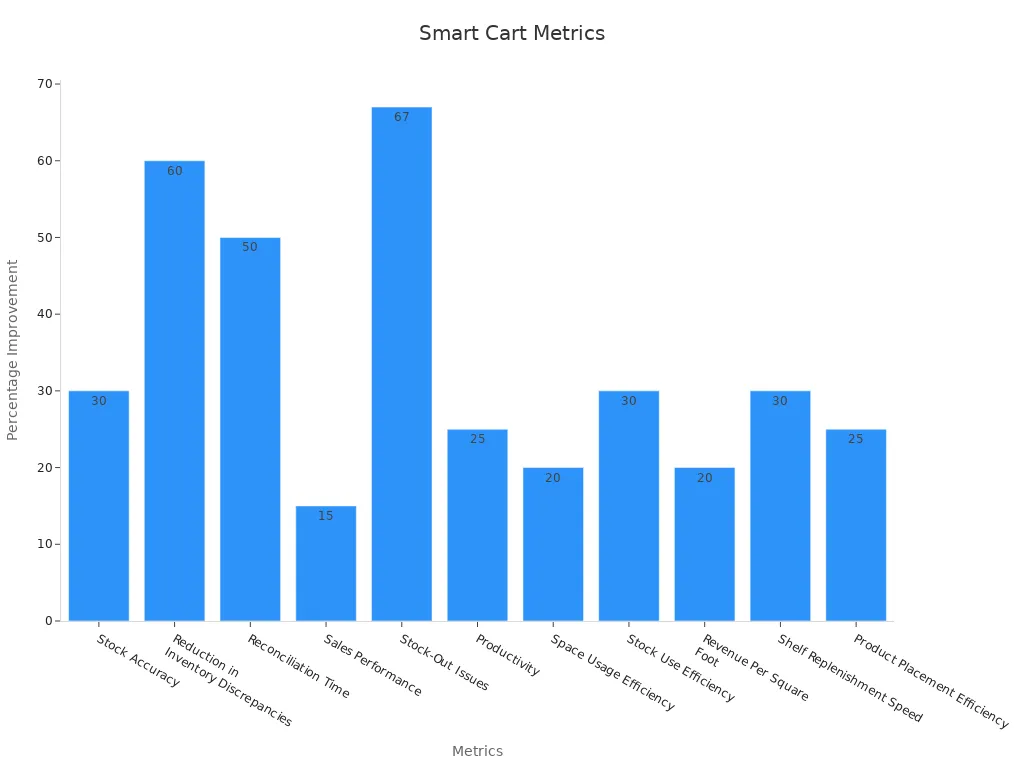Riding Shopping Cart Technology and the Future of In-Store Navigation for Retailers

Riding Shopping Cart Technology transforms how shoppers move through stores and how retailers manage operations. Retailers face mounting pressure to adapt as the market for smart trolleys is projected to reach $2.5 billion by 2032, fueled by consumer demand for convenience and efficiency.
Imagine a shopper entering a busy supermarket. A smart cart greets them, maps an optimal route, and suggests personalized deals.
Shoppers benefit from seamless navigation and self-checkout. Retailers gain access to real-time data, improved efficiency, and new revenue streams.
Region | Insight |
|---|---|
North America | |
Asia Pacific | Fastest growth, ~6.4% CAGR through 2033 |
These innovations align closely with modern consumer expectations and evolving business goals.
Key Takeaways
Smart shopping carts improve the shopping experience by guiding customers through stores, offering personalized deals, and enabling quick self-checkout.
Retailers gain real-time data to track inventory, understand shopper behavior, and optimize store layouts, leading to higher sales and lower costs.
Advanced features like AI, sensors, and mobile integration help stores reduce checkout lines, increase customer loyalty, and boost revenue.
Challenges such as system integration, staff training, and privacy concerns require careful planning but can be overcome with proper support.
Future trends include social commerce and next-generation smart carts that use IoT and AI to make shopping more interactive, efficient, and enjoyable.
Evolution
From Traditional to Smart Carts
Shopping carts began as simple wire baskets in the 1930s. Early designs focused on durability and ease of movement, with features like swivel wheels improving maneuverability. For decades, these carts remained largely unchanged, serving as basic tools for carrying groceries. In the early 2000s, retailers started experimenting with digital enhancements. Basic scanning and digital displays appeared, marking the first steps toward smarter carts.
The market for smart shopping carts reached $1.35 billion in 2022, with a projected annual growth rate of 27.6%. This rapid expansion reflects the shift in consumer expectations and the demand for contactless, tech-driven shopping experiences. Retailers adopting smart carts have seen a 10-15% increase in revenue, while shoppers using these carts report a 40% rise in average order value. Customer satisfaction scores improved by 23% when stores integrated smart carts with omnichannel strategies. Operational benefits include 20-30% reductions in costs, better inventory turnover, and fewer errors. These trends highlight the commercial and technological leap from traditional carts to advanced, data-driven solutions.
Key Innovations
Smart carts introduce a range of features that set them apart from their predecessors:
Built-in weighing systems allow immediate pricing for items sold by weight.
Real-time scanning and pricing give shoppers a running total, helping with budget management.
Personalized recommendations and discounts appear based on items placed in the cart, increasing upselling opportunities.
Data collection on shopper behavior enables retailers to analyze trends and optimize store layouts.
On-cart payment systems let customers pay without unloading items, eliminating checkout lines.
Clip-on devices upgrade existing carts, making the transition smoother for retailers.
Shopic’s rollout of 2,000 AI-powered smart carts with a major supermarket chain demonstrates the scale and impact of these innovations. Industry leaders recognize these advancements as a turning point in frictionless grocery shopping.
Smart carts now combine sensors, RFID, barcode scanners, interactive displays, and AI. These technologies enable real-time inventory management, personalized promotions, and seamless checkout, transforming the in-store experience for both shoppers and retailers.
Riding Shopping Cart Technology

Real-Time Data
Riding Shopping Cart Technology empowers retailers to collect and analyze real-time data throughout the shopping journey. Smart carts track every item added or removed, recording custom metrics such as "add_to_cart_count" to reveal product popularity and shopper interest. These systems also measure "checkout_completion_time," highlighting where shoppers experience delays. Predictive analytics use this information to anticipate trends, such as spikes in cart abandonment, and trigger targeted marketing actions like instant discounts or personalized emails.
Lotte.com, a leading Korean retailer, leveraged a customer experience dashboard to monitor real-time shopping cart abandonment. By identifying the main reasons for abandonment and acting on these insights, the company increased customer loyalty and boosted sales revenue by $10 million within a year. This example demonstrates how Riding Shopping Cart Technology can drive measurable business improvements by harnessing real-time customer behavior data.
Real-time data tracking enables instant inventory updates and customer behavior insights.
Navigation assistance guides shoppers efficiently through the store, reducing search time.
AI-driven personalization offers tailored product recommendations and promotions.
Integrated payment systems streamline checkout, reducing wait times.
Retailers benefit from enhanced inventory tracking and route optimization. Industry 4.0 technologies, including IoT and Big Data, allow stores to monitor logistics resources and determine optimal delivery routes. These advancements reduce logistics costs, energy consumption, and travel distance. Digital systems also enable near real-time interaction between customers and suppliers, improving order handling and inventory accuracy.
The impact of Riding Shopping Cart Technology on store operations appears in key performance metrics:
Metric/Feature | Improvement/Benefit |
|---|---|
Stock Accuracy | Improved by 30% |
Reduction in Inventory Discrepancies | 60% decrease |
Reconciliation Time | Reduced by 50% |
Sales Performance | Increased by 15% |
Stock-Out Issues | Reduced by 67% |
Productivity | Increased by 25% |
Space Usage Efficiency | Improved by 20% |
Stock Use Efficiency | Improved by 30% |
Revenue Per Square Foot | Up to 20% increase |
Shelf Replenishment Speed | 30% faster |
Product Placement Efficiency | 25% improvement |

In-Store Navigation
Riding Shopping Cart Technology transforms the way shoppers move through stores. Smart carts use sensors and location tracking to pinpoint a shopper’s position with an accuracy of 50 centimeters or less, even in multi-floor environments. These carts guide customers directly to the exact shelf location of each item on their list, often using interactive displays or mobile integration. Some systems enhance the experience with augmented reality, making product finding even more intuitive.
Navigation features do more than just save time. As shoppers approach specific areas, the system can flash tailored special offers, increasing basket size and driving impulse purchases. Heat map analytics reveal which store zones attract the most traffic and sales, helping retailers optimize product placement and store layout.
Evidence Aspect | Description |
|---|---|
Shopper Position Tracking | In-store navigation apps track shoppers' positions with an accuracy of 50 cm or less, including vertical positioning in multi-floor stores. |
Navigation Guidance | Shoppers are guided to exact shelf locations via mobile phones, sometimes enhanced with augmented reality. |
Real-time Marketing | The system flashes tailored special offers as shoppers approach specific areas, increasing basket size. |
Heat Map Analytics | Heat maps reveal store zones with highest sales, traffic, and dwell time, providing actionable spatial performance data for retailers. |
Eye-tracking field experiments with grocery store customers show that in-store signage and navigation tools direct visual attention during shopping. This guidance proves critical, as visual attention often leads to purchase decisions. Research indicates that in-store displays with price reductions can increase unit sales by up to 2345% of regular weekly sales, highlighting the power of effective navigation and targeted promotions.
Riding Shopping Cart Technology not only streamlines the shopping process but also enhances the overall customer experience. Shoppers find products faster, receive relevant offers, and enjoy a smoother journey from entry to checkout. Retailers gain valuable insights and operational efficiencies, positioning themselves for long-term success in a competitive market.
Experience
Self-Checkout
Smart carts have changed the checkout process in retail stores. Shoppers can scan items as they shop. They see the total cost on a digital screen. When ready, they pay directly on the cart. This system removes the need to wait in long lines. Retailers see faster transactions and fewer errors. Staff can focus on helping customers instead of running registers. Stores report higher satisfaction scores after adding self-checkout features. Shoppers enjoy a smoother and quicker end to their visit.
Personalization
Personalization stands at the core of modern smart cart technology. Smart carts use data from past purchases and in-store behavior to suggest products and deals. Shoppers receive recommendations that match their tastes and needs. This approach increases engagement and loyalty. Many leading retailers have seen strong results:
Alibaba's FashionAI stores use smart mirrors and RFID to suggest matching items, raising items per transaction by 20%.
SK-II's AI-powered stores offer personalized skincare advice, boosting conversion rates by 80% and improving first-time customer retention by 30%.
Neiman Marcus's Memory Mirror remembers previous try-ons, increasing conversion rates by 60% and reducing returns by 40%.
Metrics like repeat purchase rate and loyalty program engagement show that personalization keeps shoppers coming back.
Brands such as Sephora, Walgreens, Nike, and Target have improved customer engagement and retention with AI-driven personalization.
Accenture found that 91% of consumers prefer brands with relevant offers, and 83% will share data for better personalization.
McKinsey reports that personalization can cut acquisition costs by up to 50% and raise marketing ROI by 10-30%.
Personalized experiences make shopping more enjoyable and help retailers build lasting relationships with their customers.
Digital Advertising
Smart carts open new doors for digital advertising inside stores. Retailers display targeted ads and promotions on cart screens. These ads change based on the shopper’s location in the store and items in the cart. Shoppers see offers that match their interests. Retailers can test which ads work best and adjust campaigns in real time. This approach increases the chance of impulse buys and raises the value of each shopping trip. Digital advertising on smart carts creates a win-win for both shoppers and retailers.
AI and Integration
Predictive Analytics
Artificial intelligence drives the next wave of smart cart technology. Retailers use predictive analytics to understand and anticipate shopper needs. These systems rely on machine learning models such as classification, regression, and clustering. For example, algorithms like Decision Trees and Random Forests help predict which products a shopper might buy next. Unsupervised learning methods, including clustering and anomaly detection, uncover hidden patterns in shopping behavior.
Smart carts collect data from sensors and IoT devices. This data feeds into predictive models that forecast inventory needs and optimize supply chains. Retailers can spot trends, such as which products sell fastest or when certain items run low. Predictive analytics also helps segment customers, analyze churn, and improve in-store operations. By using these tools, stores deliver more personalized experiences and keep shelves stocked.
Predictive analytics enables retailers to offer tailored promotions, reduce waste, and improve customer satisfaction. Shoppers find what they need faster, while stores operate more efficiently.
Omnichannel Sync
Retailers now connect digital and physical shopping channels to create a seamless experience. Smart cart data analytics play a key role in this process. When stores synchronize inventory and customer data across all channels, shoppers receive real-time product information and consistent service. AI-driven algorithms personalize offers and optimize pricing, making each visit unique.
Research shows that omnichannel strategies, combined with smart cart analytics, boost customer satisfaction and loyalty. Shoppers enjoy convenience and accurate recommendations, whether they shop online or in-store. Unified commerce platforms manage inventory, fulfillment, and pricing, ensuring that every channel works together.
Personalized promotions increase engagement.
Real-time analytics improve operational efficiency.
Contactless payments and self-checkout speed up the process.
Retailers who embrace omnichannel sync with smart cart technology see higher sales and stronger brand loyalty. This approach meets the needs of today’s connected shoppers and sets the stage for future growth.
Business Impact
Engagement
Smart cart technology increases shopper engagement by making the in-store experience more interactive and enjoyable. Shoppers receive personalized recommendations and real-time promotions as they move through the aisles. These features encourage customers to explore new products and spend more time in the store. Retailers notice that shoppers who use smart carts often return more frequently and show higher loyalty. Customer retention improves by 27% when stores use data-driven personalization. This approach helps retailers build stronger relationships with their customers and keeps them coming back.
Efficiency
Retailers achieve higher efficiency with riding shopping cart technology. AI automation in smart carts tracks user behavior, detects obstacles, and optimizes routes. These features improve safety and reliability while reducing the need for manual oversight. Remote diagnostics and fleet management tools help retailers maintain their carts with less effort. Smart carts also let shoppers scan and pay for items as they shop, bringing self-checkout mobility to the sales floor. This process streamlines checkout and reduces wait times. Retailers benefit from lower operational costs and smoother store operations. Integration of AI chips and IoT modules supports advanced mobility solutions and meets consumer demand for faster, easier shopping.
Revenue Streams
Smart cart integration opens new revenue streams for retailers. Cloud-based systems allow real-time monitoring and management of sales, helping businesses spot new opportunities quickly. Retailers can optimize underused spaces or add partner services, such as EV charging stations, to boost income. Data-driven strategies lead to 30% higher revenue growth, while omnichannel integration increases average transaction values by 38%. Stores that use real-time POS insights see conversion rates rise by 21%. Inventory turnover improves by 35% with better ordering, and profit margins grow by 14.5% through smarter pricing. These improvements show how smart carts drive measurable financial gains and support long-term business growth.
Metric | Improvement (%) |
|---|---|
Revenue Growth | 30 |
Avg. Transaction Value | 38 |
Sales per Labor Hour | 22 |
Conversion Rate | 21 |
Inventory Turnover | 35 |
Profit Margin | 14.5 |
Customer Retention | 27 |
Smart cart technology transforms retail by boosting engagement, streamlining operations, and unlocking new ways to grow revenue.
Challenges
Integration
Retailers face several hurdles when adding smart cart technology to their stores.
Teams must align new devices with the core shopping experience, making sure smart carts fit smoothly into daily operations.
Hardware and software must work reliably in busy, traditional store settings.
Scaling up smart carts across many locations brings operational complexity. Retailers want to avoid hiring more staff or disrupting workflows.
Universal RFID readers present cost challenges. Products in stores range from $1 to $100, so balancing precise tracking with cost efficiency is tough.
New smart cart systems often do not work well with older inventory, POS, or CRM systems. This incompatibility can create data silos and slow down processes.
Rolling out smart carts in multiple stores requires careful planning, staff training, and ongoing maintenance.
Small and mid-sized retailers struggle more because they have fewer IT resources.
These challenges affect store operations. For example, smart carts can process 10%-30% of store revenue and reduce the need for checkout staff, but only if integration succeeds.
Privacy
Smart carts collect large amounts of data about shoppers. Many customers worry about how stores use this information. Surveys show that 49% of people believe AI will reduce privacy, and 34% feel unsure. In a recent study, many shoppers felt uncomfortable with AI analyzing their personal data. Privacy concerns also stop some people from using smart devices. About 40% of users worry about how voice data is handled. Studies on smart home devices, which work like smart carts, show that privacy fears lower the chance of adoption. Retailers must address these concerns to build trust and encourage more people to use smart carts.
Training
Employees need training to use and support smart cart technology. Staff must learn how to help shoppers with new features and troubleshoot problems. Training programs should cover both technical skills and customer service. Well-trained employees can answer questions, fix minor issues, and keep the carts running smoothly. Ongoing support and refresher courses help staff stay up to date as technology changes. Retailers who invest in training see fewer errors, faster adoption, and higher customer satisfaction.
Future Trends

Social Commerce
Social commerce is changing how people shop in stores. Retailers now connect shopping carts with social media platforms. Shoppers can share their favorite products or deals with friends while they shop. Some smart carts let users scan QR codes to join live streams or see product reviews from other customers. These features help shoppers make better choices and feel more connected.
Retailers use social commerce to reach new customers and build loyalty. They can offer special discounts to shoppers who share their purchases online. This approach turns every shopper into a brand ambassador. Stores also collect feedback from social media to improve products and services. As social commerce grows, retailers must stay flexible and ready to try new ideas.
Social commerce brings the online community into the store, making shopping more interactive and fun.
Next-Gen Features
Smart cart technology continues to evolve with new interactive and IoT features. Retailers now use RFID technology for wireless product tracking and real-time inventory management. Sensors and integrated systems automate billing and give shoppers personalized recommendations. Deep learning and object detection help carts recognize products and improve accuracy.
Cloud and fog computing allow carts to process data quickly, so shoppers get instant updates and suggestions. These systems also help retailers manage inventory and store layouts more efficiently. Built-in self-checkout features, barcode scanners, and payment terminals reduce wait times and make shopping easier.
IoT-enabled carts collect real-time data on customer behavior and cart location.
Smart carts guide shoppers through stores, optimizing routes based on shopping lists.
Advanced tracking helps retailers improve traffic flow and boost engagement.
Retailers should invest in staff training and upgrade their technology to keep up with these changes. They need to focus on device compatibility, security, and scalability. By staying informed and open to new solutions, retailers can lead the way in smart cart innovation and meet the needs of tomorrow’s shoppers.
Riding Shopping Cart Technology has changed how retailers operate and how shoppers move through stores. Smart carts now deliver real-time assistance, boost sales, and help stores manage inventory better. Industry leaders see these tools as essential for meeting new consumer demands. Instacart’s plan to roll out thousands of smart carts shows this shift is here to stay. Retailers should review their readiness, invest in innovation, and lead the way as technology shapes the future of shopping.
FAQ
What is riding shopping cart technology?
Riding shopping cart technology uses smart carts with sensors, screens, and AI. These carts help shoppers find products, track spending, and check out faster. Retailers use the data to improve store layouts and offer better deals.
How do smart carts improve in-store navigation?
Smart carts guide shoppers to products using digital maps and real-time location tracking. Shoppers save time and avoid confusion. Retailers see smoother traffic flow and higher customer satisfaction.
Are smart carts secure for personal data?
Retailers use encryption and strict privacy policies to protect shopper data. Most systems collect only shopping behavior, not personal identity. Shoppers can review privacy settings on the cart’s display.
What challenges do retailers face when adopting smart carts?
Integration with old systems can be difficult.
Staff need training to support new technology.
Privacy concerns may slow adoption.
Upfront costs can be high for smaller stores.
Challenge | Impact |
|---|---|
Integration | Slower rollout |
Training | Staff adjustment |
Privacy | Customer hesitation |
Cost | Budget constraints |
See Also
The Future Of Retail Lies In AI-Powered Stores
What Retailers Should Understand About AI-Driven Corner Stores
Transforming Online Store Management With AI E-Commerce Tools
Walgreens Self-Checkout: Balancing Convenience And Retail Challenges
